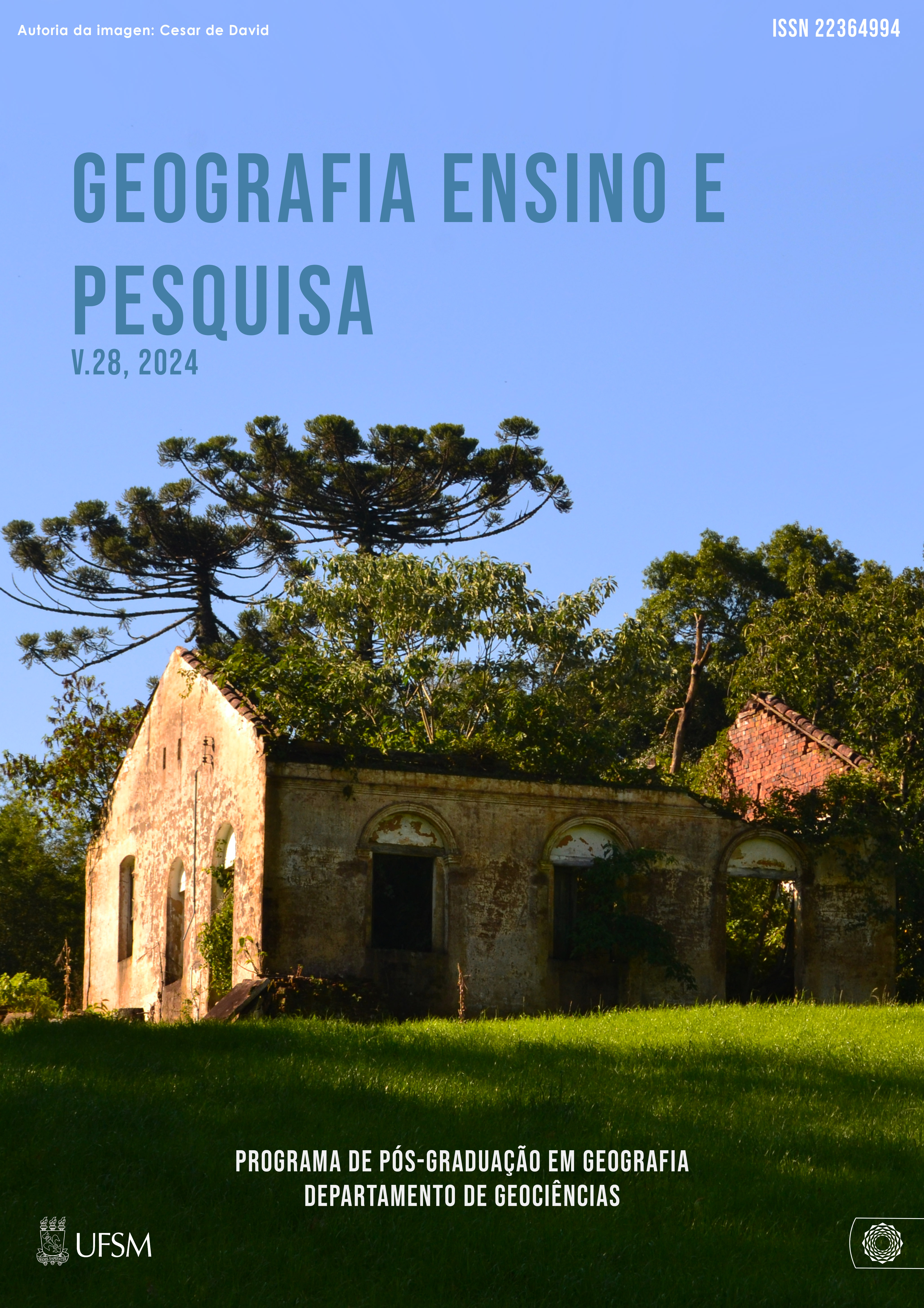Geography in the BNCC: reflections on the contents of urban-industrial society and its energy sources
DOI:
https://doi.org/10.5902/2236499487761Keywords:
Education, Geography teaching, BNCC, ChallengesAbstract
In Brazil, the issue of education is almost always neglected and misrepresented in order to keep the interests of dominant political and economic groups intact. This can be seen in the 1988 Federal Constitution, which exemplifies the responsibility of the Brazilian state towards public education. However, in the years that followed, the thesis adopted was that the “Constitution didn't fit into the Budget,” based on the Fiscal Responsibility Law and the apparent primacy of other non-social issues. That said, in 2017, on flimsy and sometimes undemocratic allegations, the Common National Curriculum Base (BNCC) was approved. In view of this, this paper will analyze the challenge of applying the BNCC to Geography, looking at the content of urban-industrial society and energy sources taught in Year 9 at the Professor Nestor Carvalho Lima State School, located in the municipality of Itabaiana/SE. To this end, historical-dialectical materialism draws the path to be followed in the process of understanding social reality, reflecting the class experience lived during the supervised internship as a prerequisite for completing the Geography Course (DGEI/UFS). The teaching resources used during the meetings were: blackboard, paintbrush, textbook, images, newspaper articles, smartphones as well as the use of cartoons, maps, graphs, and notebooks. Teaching materials were made in the classroom, the textbook was used, and activities were developed that enabled the trainee and the students to make progress in their learning throughout the teaching process.
Downloads
References
ADAS, Melhem. Expedições geográficas: manual do professor. 3. ed. São Paulo: Moderna, 2018. p. 60-75.
ALBUQUERQUE, Maria Adailza Martins de et. al. Manifesto: crítica às reformas neoliberais na educação: prólogo do ensino de geografia. Marília: Lutas Anticapital, 2021. 169 p. ISBN 978-65-86620-61-0
BRANDÃO, Carlos Rodrigues. O que é educação. 33. ed. São Paulo: Brasiliense, 1995. p. 7-35. ISBN 85-11-01020-3
BRASIL. Ministério da Educação. Base Nacional Comum Curricular. Brasília, 2017. Disponível em: http://portal.mec.gov.br/index.php?option=com_docman&view=download&alias=79601-anexo-texto-bncc-reexportado-pdf-2&category_slug=dezembro-2017-pdf&Itemid=30192. Acesso em: 07 mai. 2024.
CARVALHO, D. M. de. Comercialização Agrícola em Itabaiana – SE. 1. ed. Aracaju: Criação Editora, 2023. Disponível em < https://editoracriacao.com.br/comercializacao-agricola-em-itabaiana-se/>. Acesso em 04 jun. 2024.
CRUZ, Francisco Herbster Alencar et. al. Análise crítico-compreensiva da Base Nacional Comum Curricular voltada para os conteúdos de Geografia Física na Educação Básica. REGNE, v. 2, n° especial, p. 1401-1410, 2016.
CUT BRASIL. Bolsonaro corta mais de R$ 1 bi na educação e escolas e universidades podem fechar. Disponível em: https://www.cut.org.br/noticias/bolsonaro-corta-mais-de-r-1-bi-na-educacao-e-escolas-e-universidades-podem-fecha-0f62. Acesso em: 09 out. 2022.
FARIAS, Paulo Sérgio Cunha. A Lei 13.415/2017 e o lugar da Geografia Escolar na estrutura curricular do Ensino Médio. Revista Ensino de Geografia, Recife, v. 03, n°. 2, p. 1-18, 2020.
GONÇALVES, Juliano Rosa. Uma nova Geografia Escolar a partir da Base Nacional Comum Curricular: apontamentos sobre os livros didáticos de Ciências Humanas e Sociais Aplicadas. Revista Ensino de Geografia, Recife, v. 05, n°. 1, p. 191-216, 2022. ISSN 2594-9616.
INSTITUTO BRASILEIRO DE GEOGRAFIA E ESTATÍSTICA (IBGE). Cidades - 2022. Disponível em: https://cidades.ibge.gov.br/brasil/se/itabaiana/panorama. Acesso em: 19 out. 2024.
LESSA, Sérgio. Para compreender a ontologia de Lukács. 4. ed. São Paulo: Instituto Lukács, 2015.
MÉSZÁROS, István. Para além do Leviatã: crítica do Estado. São Paulo: Boitempo, 2021. ISBN 978-65-5717-103-5
PACÍFICO, Marsiel. Materialismo histórico-dialético: gênese e sentidos do método. Argumentos: Revista de Filosofia. Fortaleza, v. 11, n. 21, p. 220-231, jan.-jun. 2019. Disponível em: http://www.periodicos.ufc.br/argumentos/article/view/41057. Acesso em: 11 mai. 2021.
PAULO NETTO, José. Introdução ao estudo do método de Marx. 1. ed. São Paulo: Expressão Popular, 2011. 64 p. ISBN 978-85-7743-182-3
Qeduc. IDEB. Brasília, 2023. Disponível em <https://qedu.org.br/municipio/2802908-itabaiana/ideb>. Acesso em 18 out. 2024.
SAVIANNI, Dermeval. Escola e democracia: teorias da educação, curvatura da vara, onze teses sobre a educação política. 33. ed. Campinas: Autores Associados, 2000.
UOL. Merenda escolar sem reajuste faz com que crianças dividam até ovo. Disponível em: https://educacao.uol.com.br/noticias/agencia-estado/2022/09/16/merenda-escolar-sem-reajuste-faz-com-que-criancas-dividam-ate-ovo.htm. Acesso em: 09 out. 2022
Downloads
Published
How to Cite
Issue
Section
License
Copyright (c) 2024 Geografia Ensino & Pesquisa

This work is licensed under a Creative Commons Attribution-NonCommercial-ShareAlike 4.0 International License.
The journal Geografia – Ensino & Pesquisa will obtain the auctorial rights for all published texts. This also implies that the text can be published anywhere in the world, including all rights on renewal, expansion and dissemination of the contribution, as well as other subsidiary rights. The author’s get permission to publish the contribution in other medias, printed or digital, may be in Portuguese or translation, since the publication is credited to Revista Geografia – Ensino & Pesquisa.The journal Geografia – Ensino & Pesquisa will obtain the auctorial rights for all published texts. This also implies that the text can be published anywhere in the world, including all rights on renewal, expansion and dissemination of the contribution, as well as other subsidiary rights. The author’s get permission to publish the contribution in other medias, printed or digital, may be in Portuguese or translation, since the publication is credited to Revista Geografia – Ensino & Pesquisa.







